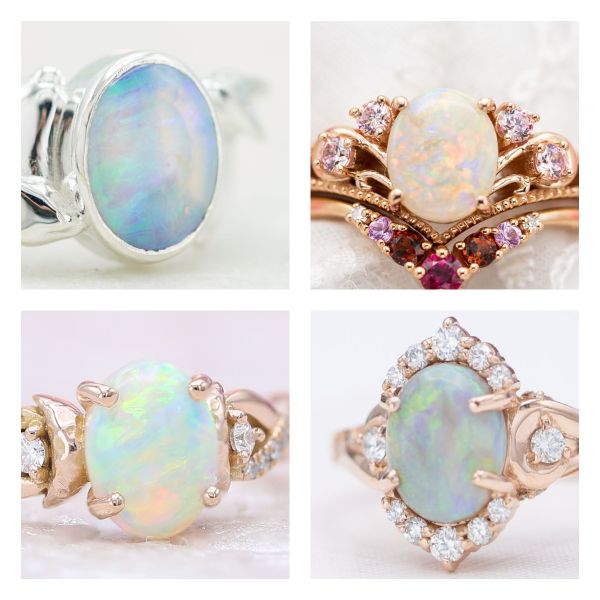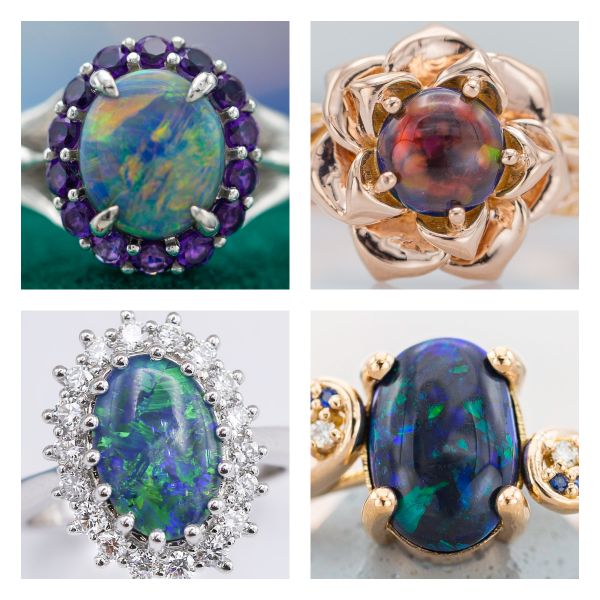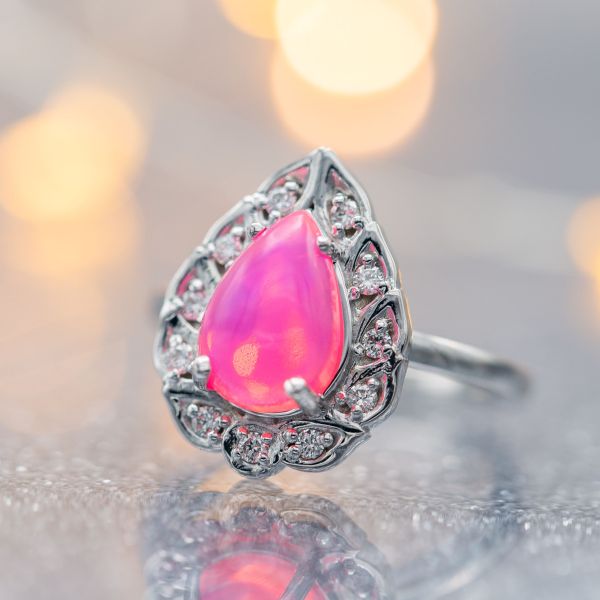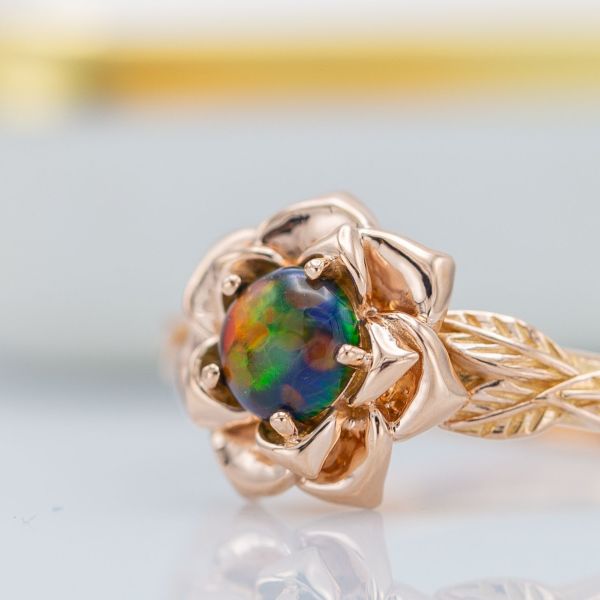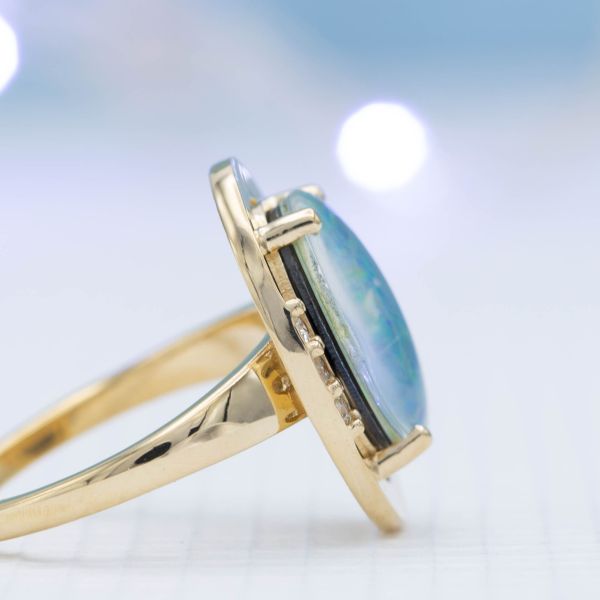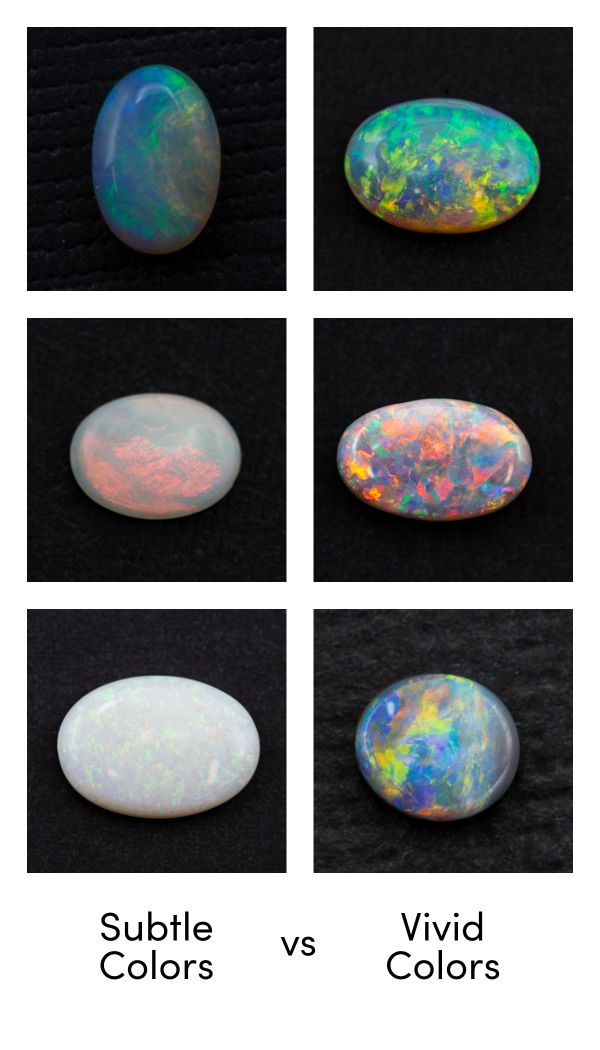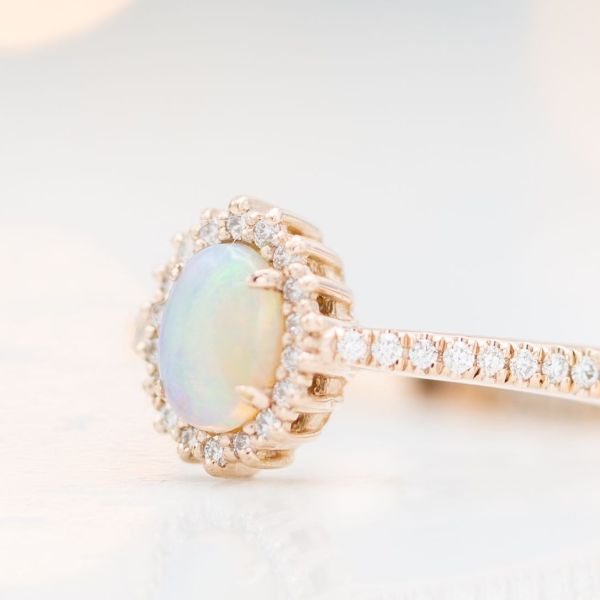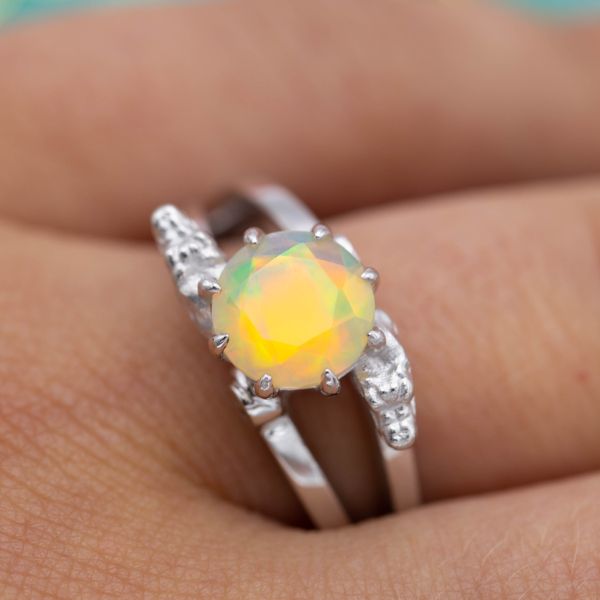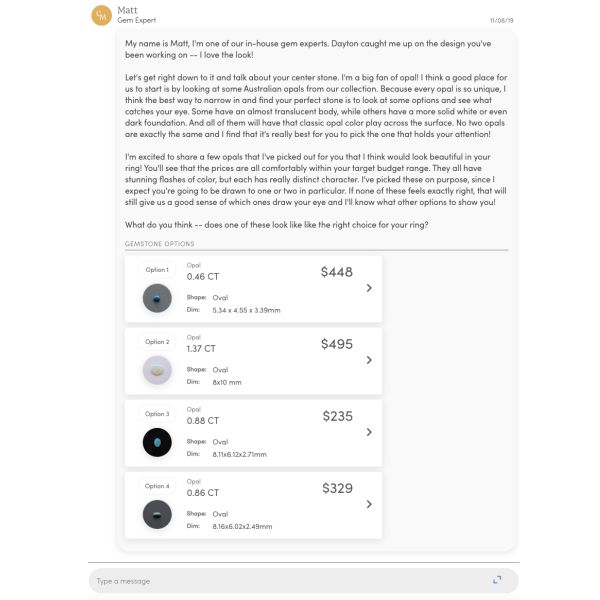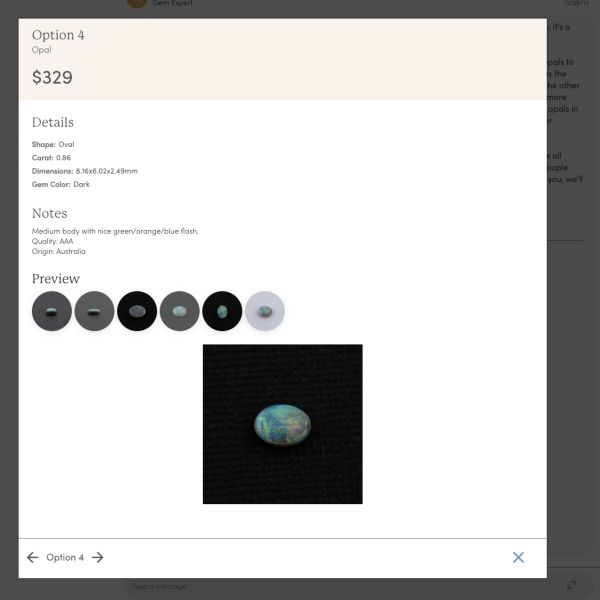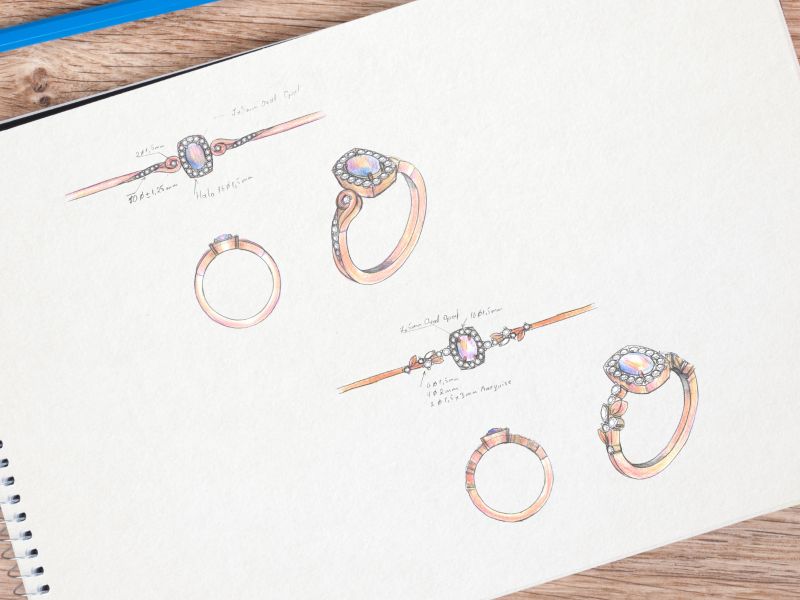Gemstone Knowledge
How to pick the perfect opal
A practical guide to opal type, color, and price
So, you've done your research, considered the stone's durability, and decided that opal is the right center stone for you. Wonderful choice! But how do you find the right opal? This guide covers the basic concepts we go over with our customers to help them choose their perfect opal. With the right guidance, choosing an opal is both simple and fun. Each opal is unique, so more than anything, we recommend looking at high-quality images of each opal you're considering before making a decision.
If you already know the exact type of opal you're looking for, you can skip right ahead to looking at photos to find the one that calls to you. But if you're less familiar, we recommend a few simple steps to think through the look and price that's right for you.
Step 1: Find the right type
In our article on opal varieties, you can read about the many types of opal. But for most people, the first decision is straightforward: are you looking for the understated shimmer of white opal or for the rich, intense colors of black opal? Take a look at these examples and see which type is closer to the look you have in mind.
- White opal. If you're looking for the classic opal look that's most common in the United States, we recommend a white opal. They come in all different shades of flash, the most common being large rolling flashes of blue green or small rainbow pinfire flashes.
- Black opal. If you're looking for more color intensity, we recommend black opals. "Black" doesn't mean that the opal itself looks black, it means that it has a deep body tone. Darker body tones showcase color flash more intensely, making black opals capable of showing more vivid blues, oranges, and greens.
Of course, there is a lot of nuance and subtlety beyond this simple decision, but we can get to that in the next few steps. Also, there are absolutely any number of opal styles beyond these types. White and black opals are by far the most common starting point, but if you have a different look in mind, you can skip ahead to looking for exactly that type with our gem experts. As you can see from these example images, we're happy to help you track down everything from a bright orange fire opal to a bubblegum pink opal or a dusky purple opal:
Step 2: Check your budget
Now that you have a sense of the opal type you'll want, we recommend pausing to think about your budget.
White Opal
If white opal looks right for you, ours typically sell for $150-400. This is, for most, a budget friendly center stone. For those interested in a large center stone with rare color flash, lab-made white opals are a good option to consider. A man-made white opal will provide opal's distinctive beauty at a reasonable price point, even if you need a particularly large size or an unusual shape.
Black Opal
Black opals are only found in a few different locations in Australia. Their rarity means they are more valuable. Ours usually sell for $500-4,000. That large price range is driven by the color intensity, size, and shape of each individual opal. And, for some, that can mean the perfect opal is out of their price range. Here, too, there are a few alternatives to consider if you need to keep costs down:
- Lab-made. As with white opals, you can find lab-created black opals that offer the right look at a lower price. Some people want the romance of knowing their stone was created in nature. Others are more interested in the appearance, and may find man-made opals to be just right for their ring.
- Imperfect perfection. If you're willing to be a little flexible on the appearance, there are often dark opals or slightly imperfect opals that offer the vivid colors of a black opal at a discount. For example, if your design will set the opal in a bezel, you may be comfortable with imperfect edges, since your setting will hide them.
- Doublets. One other option is to consider a doublet, which is an assembled gemstone created by attaching a thinner layer of precious opal onto a dark backing (usually made of potch, the non-precious form of opal). This option offers a middle ground, since the doublet is hand-assembled, but its beauty comes from natural opal.
Light Opal, Dark Opal, Crystal Opal, and more
Since we've focused on white and black opal, the prices above give a good sense of the range you can expect to pay, depending on the look you have in mind. As we narrow in on the right appearance, we may consider options that are technically classified in between. Our gem experts may help you consider stones that are technically classified as light or dark opals, which have body tones that are in between white and black opal. You might also consider some crystal opals, which have a totally transparent body color with vivid color flash. Finally, there are types like Mexican fire opal that may be right for you. Prices for most of these other opal types will fall into a similar range. Stones like fire opal and lab-made opals will have similar prices to white opal, while dark and crystal opals will typically cost $300-2,000.
Dragon's Breath Opal, Galaxy Opal, etc.
Opal types can be confusing and there are a number of terms that are frequently misunderstood. To make matters worse, some jewelers use terms like galaxy opal to refer to fake imitation opal. We don't sell imitation opal and we don't recommend it as an alternative, since higher quality options are readily available at affordable prices. For more detail, check out our article on opal types.
Step 3: Find the right style
Now that we have a good sense of the type of opal you have in mind, we can narrow in on the exact right stone with a few key questions:
- Are you looking for intense or subtle flashes of color?
- Do you prefer an opaque or transparent background?
- Do you want mostly warm or cool colors?
Take a minute to consider which characteristics you like. There are endless combinations available, so knowing the kinds of details you particularly like will help our gem specialists hand-pick opals that you're most likely to love.
Step 4: Pick your shape
Opals typically come in a cabochon cut — meaning that they have a flat bottom with a smooth domed top. This cut is the best for showcasing play of color. As for shape, oval and round are the most common, followed by pear shape and marquise. We recommend these four shapes as the best way to showcase opal's beauty.
That said, we can custom cut opal into just about any shape or cut. For example, some people love the look of opal when it's cut into the faceted shape more typically used for diamonds and other gemstones. The combination is unusual and beautiful.
Step 5: Review individual stones
Each natural opal is unique, which is why it's critical that you see high quality images of your exact opal. If possible, look at images with different angles and on both light and dark backgrounds. Many opals are semi-translucent, and their color can look substantially different depending on the background. Photos solely on a black background are insufficient and may suggest more intense color flash than actually exists.
How does this all work at CustomMade? Our gem experts walk each of our customers through a consultation, asking questions like the ones outlined above, and then selecting opals that fit the look, style, and budget criteria discussed. These options are presented in detail, with suggestions on how to compare and make a decision. And, most importantly, every opal we show our customers includes a range of professional photos from numerous angles, and on both light and dark backgrounds. Here's an example of what this experience looks like:
Step 6: Check for durability
Hopefully you've already read about and considered the durability of your opal. But it's important, so we'll mention it here. Opals are one of the more delicate gemstones we sell, so before you buy it's important to make sure you're comfortable with the care requirements and risk of damage.
Step 7: Design your setting
Now that you've picked the perfect gemstone, it's time to design the piece that will showcase your opal. If you haven't already designed it, now comes the fun part where you create a setting that's as personal and meaningful as the opal you just selected. Ready to get started? Click here to connect with a member of our design team.
About CustomMade
CustomMade designs and creates one-of-a-kind, custom engagement rings and fine jewelry. Each piece we create is inspired by you, designed for you, and made just for you.
